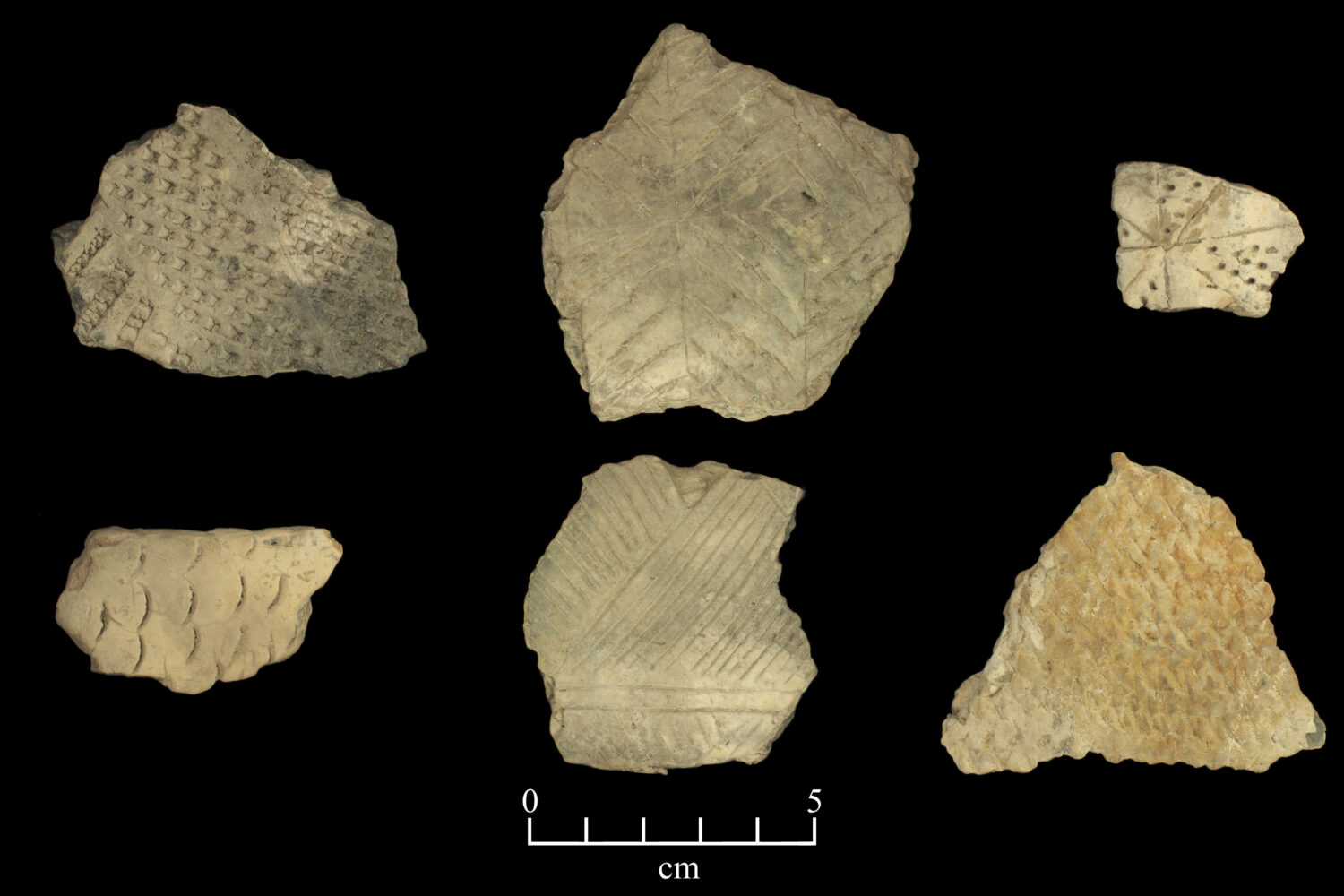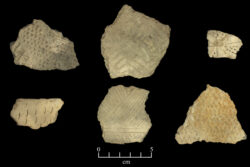Tchefuncte Culture
Tchefuncte culture flourished in Louisiana during the Early Woodland Period from 800 BCE to 1 CE.

R. Christopher Goodwin & Associates, Inc. and FEMA
Examples of Tchefuncte pottery recovered from the Bayou Jasmine Site in St. John the Baptist Parish, Louisiana.
People designated by archaeologists as members of the “Tchefuncte culture” lived in the Lower Mississippi River Valley and along the Gulf of Mexico from at least as early as 800 BCE. to around 1 CE. Tchefuncte communities were present in most of Louisiana, southeastern Arkansas, much of coastal and western Mississippi, and extreme southeastern Texas. Like their Late Archaic and Poverty Point predecessors, the Tchefuncte were fishers, hunters, and gatherers. However, Tchefuncte peoples did not build massive earthworks and extensive trade networks like the Poverty Point folk did, and the Tchefuncte are considered somewhat devolved from the Poverty Point pinnacle. But, unlike their predecessors, who must have been aware of pottery but did not use it to any great extent, Tchefuncte people took to making clay pots with gusto. In addition, Tchefuncte people constructed some of the earliest burial mounds in Louisiana.
Tchefuncte Culture: Definition and Important Sites
The culture name “Tchefuncte” is shared by the name of the “type site”—the site that was used to define the culture. The Tchefuncte site is on the northern shore of Lake Pontchartrain in St. Tammany Parish. It consists of two large middens (trash heaps) made of earth and shell. Midden A measured 250 x 100 feet and Midden B, which had been mined for shell, was 150 x 100 feet. The Tchefuncte site middens contained food bone and shell; broken pottery; bone, shell, and stone artifacts; and burials. Archaeologists first excavated the Tchefuncte site in the late 1930s and early 1940s. The data generated by the excavations were crucial in constructing the chronological sequence of prehistoric cultures in the region.
There has been enough archaeological work related to the Tchefuncte culture to determine that Tchefuncte people lived in discrete clusters, called phases by archaeologists. There are at least twelve of these cultural phases spread across the region. All phases are similar enough to one another to be considered Tchefuncte, yet they are distinctive enough in space and in subtle differences in pottery types to be considered discrete “districts” of interacting sites. Within each phase, small residential sites housed egalitarian bands (groups of less than one hundred people), perhaps composed of one or two extended lineages. A few districts may have included a central ceremonial site, where people from all the sites in the district would gather at certain times of the year. The ceremonial site likely would have had an associated burial mound (more on this below).
Interior residential sites are generally earth middens situated near slow-moving, secondary streams, such as Bayou Maçon in northeast Louisiana or Bayou Teche in south-central Louisiana. Interior Tchefuncte people probably also hunted in upland areas—for instance, in the Florida Parishes, where stone points (but rarely middens) can be found in almost any plowed field after a rain. Unfortunately, points produced between about 3000 BCE and 400 CE (from the Late Archaic through the early Woodland periods) look very similar, so these hunting locales often cannot be attributed to a specific culture.
In coastal areas, both shell and earth middens occur. There is a massive shell midden at the Bayou Jasmine site, in St. John the Baptist Parish, where Tchefuncte deposits are over eight feet deep. Sites such as this are considered special-purpose shellfish- and fish-processing locations used seasonally when desired resources were at their peak abundance. Bayou Jasmine appears to have been occupied primarily in the spring. Other sites have only earth middens. Postholes have been found at some of these sites. Although no well-defined house structures have been identified, these are considered habitation sites.
Tchefuncte Culture Artifacts
Pottery of the Tchefuncte culture is quite distinctive in appearance, primarily because its makers used a clay paste that was not wedged (kneaded). When viewed in cross section, a sherd (fragment) of Tchefuncte pottery is characteristically contorted and laminated. Tchefuncte potters also did not add temper to their clay. Temper can be sand, grog (crushed sherds), bone, crushed shell, or Spanish moss—basically anything that opens up the dense clay paste to allow for more thorough firing. Tchefuncte sites have a lot of pottery, probably because many pots failed during firing due to lack of paste preparation. Although pottery had been made since at least 3000 BCE on the lower Atlantic coast, Tchefuncte people were the first in Louisiana to create their own pottery for widespread use. Tchefuncte potters were aware of other pottery traditions in the Southeast, and even decorated their pottery with borrowed designs. However, they may have only seen finished, fired pots, and did not know about the clay preparation steps, or it did not matter to them if the pots broke during firing or use.
Although the paste of Tchefuncte pottery is comparatively crude, the surface decorations are quite varied and were often applied with great skill. Decorative techniques include (1) incising in straight or curved lines; (2) incising in straight or curved lines and at the same time jabbing the incising tool into the clay at regular intervals (called drag-and-jab incising); (3) rocker stamping to produce zigzag designs; (4) straight-line simple stamping; (5) punctations; and, (6) infrequently using a cord to impress a textured pattern into the clay. Tchefuncte vessels typically consist of globe-shaped pots, simple bowls, and jars with slightly constricted necks and flaring rims. Jars sometimes have little feet, or podal supports.
Other common Tchefuncte artifacts include tubular pottery pipes (both plain and decorated with incisions and punctations); bone tools that are typically geared to hunting and fishing (e.g., fishhooks, socketed or hollowed-out bone points); shell tools (adzes for smoothing wood and hammers for pounding); and ornamental pendants. Stone artifacts are much less common, although chipped and ground-stone implements do occur. These include stone points (generally considered to be the tips of lightweight spears thrown with atlatls), net weights, hammerstones, atlatl weights, mortars, and fragments of soapstone vessels.
Since stone suitable for points is not present throughout much of Louisiana, many Tchefuncte people either traded for stone or for finished tools. While Tchefuncte peoples did not have anything comparable to the extensive trade network of the earlier Poverty Point culture, stone sources ranged from central Louisiana to the Tennessee River Valley. In addition, Tchefuncte sites in some of the eastern phases almost always yield a few sand-tempered sherds representative of the Alexander culture centered along the Tennessee and Tombigbee Rivers.
Daily Lives and Deaths
Seasonal markers provided by food remains (e.g., migratory waterfowl, types of burned seeds recovered) indicate that Tchefuncte people lived in their habitation sites in all seasons and possibly throughout the year. They exploited shellfish, mostly clams, and many species of fish, mammals, birds, reptiles, and amphibians. They also gathered a variety of plant foods.
Most Tchefuncte burials were placed in middens, where they were interred in shallow pits, in flexed positions (knees drawn up towards the chest), or as bundle burials. Bundle burials are “secondary burials”; the body decomposed elsewhere and only the larger bones (generally the long bones and crania) were gathered into a packet for burial. A study of long bones from bundle burials at the Tchefuncte site indicates that the long bones were broken into three to five pieces in a specific, presumably ritual procedure. Grave offerings were only very rarely placed with Tchefuncte burials.
Until the 1980s, archaeologists debated whether Tchefuncte people built mounds as part of their traditional culture, or whether the earliest burial mounds in Louisiana occurred only after Tchefuncte people were heavily influenced by the northern Hopewell culture, at which point Tchefuncte people evolved into a new culture that archaeologists term Marksville. Recent excavations at the St. Mary’s Mound in Madison Parish, coupled with a reevaluation of the Lafayette Mounds in St. Martin Parish, indicate that people of the Tchefuncte culture did build mounds before any other aspects of the Marksville culture were adopted. In general, Tchefuncte mounds were circular in outline and conical in shape, and ranged anywhere from a foot or two in height to more than fifteen feet tall. Society members buried in mounds may have been important individuals; however, they had no burial goods.
Human bone can be studied to reveal demography, diet, general health, and the presence of specific diseases that affect bone. Unfortunately, in acidic, clayey sediments, bone erodes rapidly—the burials from the Lafayette Mounds were in very poor condition. However, bone is well-preserved in shell middens. While fisher-hunter-gatherer populations are generally quite healthy, burials from the shell middens at the Tchefuncte site indicate endemic bacterial treponema infection, which produces an eye disease called yaws and congenital syphilis (but not venereal syphilis). Many people also suffered from iron-deficiency anemia. Exostoses (abnormal bone growths in the ear canal, also called surfer’s ear) indicate repeated exposure to cold water and wind.
A number of traits associated with Tchefuncte culture carried over into the subsequent Marksville culture. However, mortuary treatment within the mounds was different, and new designs appeared on pottery. Indeed, at the Big Oak Island site in eastern Orleans Parish, it is possible to see an early transition from Tchefuncte cultural practices to Marksville traits. Much of the site is composed of a massive shell midden similar to that at Bayou Jasmine. Typical Tchefuncte burials were found in the midden. However, at the highest part of the site, a probable ossuary (a repository for masses of human bone) was discovered. The ossuary was radiocarbon dated to around 90 BCE (uncorrected, on charcoal) and included disarticulated human remains found in several bone concentrations. Grave goods, like quartz crystals, were present in this ossuary, as were several pottery vessels that had Marksville culture designs on Tchefuncte pottery paste.
Final Thoughts
Big Oak Island provides a rare opportunity to study the transition from the Tchefuncte to the Marksville culture. The Tchefuncte people at the site were beginning to adopt the mortuary traditions and material culture that defines them as Marksville. Notably, once the Marksville ossuary was deposited, Big Oak was abandoned. Radiocarbon dates from the site suggest this abandonment occurred around 1 CE. Occupation of the Bayou Jasmine site also ceased at about this same time—there are just a few Marksville sherds above the Tchefuncte shell midden. For whatever reason, around the turn of the century, Marksville people in this area moved away from their traditional sites.
